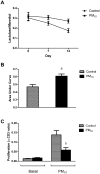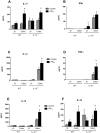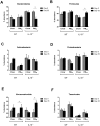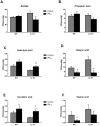Environmental particulate matter induces murine intestinal inflammatory responses and alters the gut microbiome
- PMID: 23638009
- PMCID: PMC3634745
- DOI: 10.1371/journal.pone.0062220
Environmental particulate matter induces murine intestinal inflammatory responses and alters the gut microbiome
Abstract
Background: Particulate matter (PM) is a key pollutant in ambient air that has been associated with negative health conditions in urban environments. The aim of this study was to examine the effects of orally administered PM on the gut microbiome and immune function under normal and inflammatory conditions.
Methods: Wild-type 129/SvEv mice were gavaged with Ottawa urban PM10 (EHC-93) for 7-14 days and mucosal gene expression analyzed using Ingenuity Pathways software. Intestinal permeability was measured by lactulose/mannitol excretion in urine. At sacrifice, segments of small and large intestine were cultured and cytokine secretion measured. Splenocytes were isolated and incubated with PM10 for measurement of proliferation. Long-term effects of exposure (35 days) on intestinal cytokine expression were measured in wild-type and IL-10 deficient (IL-10(-/-)) mice. Microbial composition of stool samples was assessed using terminal restriction fragment length polymorphism. Short chain fatty acids were measured in caecum.
Results: Short-term treatment of wild-type mice with PM10 altered immune gene expression, enhanced pro-inflammatory cytokine secretion in the small intestine, increased gut permeability, and induced hyporesponsiveness in splenocytes. Long-term treatment of wild-type and IL-10(-/-) mice increased pro-inflammatory cytokine expression in the colon and altered short chain fatty acid concentrations and microbial composition. IL-10(-/-) mice had increased disease as evidenced by enhanced histological damage.
Conclusions: Ingestion of airborne particulate matter alters the gut microbiome and induces acute and chronic inflammatory responses in the intestine.
Conflict of interest statement
Figures







Similar articles
-
Exposure to ingested airborne pollutant particulate matter increases mucosal exposure to bacteria and induces early onset of inflammation in neonatal IL-10-deficient mice.Inflamm Bowel Dis. 2014 Jul;20(7):1129-38. doi: 10.1097/MIB.0000000000000066. Inflamm Bowel Dis. 2014. PMID: 24859295
-
Composition and immuno-stimulatory properties of extracellular DNA from mouse gut flora.World J Gastroenterol. 2017 Nov 28;23(44):7830-7839. doi: 10.3748/wjg.v23.i44.7830. World J Gastroenterol. 2017. PMID: 29209124 Free PMC article.
-
Degree of colitis correlates with microbial composition and cytokine responses in colon and caecum of Gαi2-deficient mice.FEMS Microbiol Ecol. 2016 Jul;92(7):fiw098. doi: 10.1093/femsec/fiw098. Epub 2016 May 8. FEMS Microbiol Ecol. 2016. PMID: 27162181
-
Leaky Gut: Effect of Dietary Fiber and Fats on Microbiome and Intestinal Barrier.Int J Mol Sci. 2021 Jul 16;22(14):7613. doi: 10.3390/ijms22147613. Int J Mol Sci. 2021. PMID: 34299233 Free PMC article. Review.
-
Contribution of Non-immune Cells to Activation and Modulation of the Intestinal Inflammation.Front Immunol. 2019 Apr 10;10:647. doi: 10.3389/fimmu.2019.00647. eCollection 2019. Front Immunol. 2019. PMID: 31024529 Free PMC article. Review.
Cited by
-
Inflammatory bowel disease and airway diseases.World J Gastroenterol. 2016 Sep 14;22(34):7735-41. doi: 10.3748/wjg.v22.i34.7735. World J Gastroenterol. 2016. PMID: 27678355 Free PMC article. Review.
-
Air pollution, dysbiosis and diseases: pneumonia, asthma, COPD, lung cancer and irritable bowel syndrome.Future Microbiol. 2024;19(17):1497-1513. doi: 10.1080/17460913.2024.2401263. Epub 2024 Sep 30. Future Microbiol. 2024. PMID: 39345043 Review.
-
Codium fragile Suppresses PM2.5-Induced Cognitive Dysfunction by Regulating Gut-Brain Axis via TLR-4/MyD88 Pathway.Int J Mol Sci. 2023 Aug 17;24(16):12898. doi: 10.3390/ijms241612898. Int J Mol Sci. 2023. PMID: 37629080 Free PMC article.
-
Establishment of particulate matter-induced lung injury model in mouse.Lab Anim Res. 2021 Jul 30;37(1):20. doi: 10.1186/s42826-021-00097-x. Lab Anim Res. 2021. PMID: 34330339 Free PMC article.
-
The effect of benzo[a]pyrene on the gut microbiota of Nile tilapia (Oreochromis niloticus).Appl Microbiol Biotechnol. 2021 Oct;105(20):7935-7947. doi: 10.1007/s00253-021-11592-5. Epub 2021 Sep 20. Appl Microbiol Biotechnol. 2021. PMID: 34542683
References
-
- Sarkar S, Khillare PS (2012) Profile of PAHs in the inhalable particulate fraction: source apportionment and associated health risks in a tropical megacity. Environ Monit Assess. - PubMed
-
- Brunekreef B, Holgate ST (2002) Air pollution and health. Lancet 360: 1233–1242. - PubMed
-
- Chen TM, Shofer S, Gokhale J, Kuschner WG (2007) Outdoor air pollution: overview and historical perspective. Am J Med Sci 333: 230–234. - PubMed
Publication types
MeSH terms
Substances
Grants and funding
LinkOut - more resources
Full Text Sources
Other Literature Sources
Molecular Biology Databases

